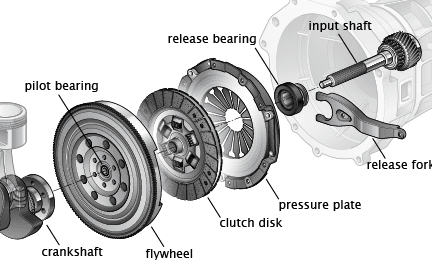Rev up your engines, folks! Today, we're diving into the world of clutches in cars. No, not the kind you find in a fancy handbag, but the trusty mechanical system that keeps your ride in check. Let's see what this crucial component is all about. Think of the clutch as the wingman of your car's transmission. Its main job? To smoothly transfer power from the engine to the gearbox, allowing you to shift gears and control the speed of your vehicle like a pro.
Engagement and Disengagement of Power
Picture this: when you press the clutch pedal, you disengage the engine from the wheels, giving you the freedom to shift gears without that jerky motion. Release the pedal, and boom – power's back on!
Facilitating Gear Changes
Ever wonder how you smoothly transition from first gear to second without sounding like a clunky old tractor? Thank your trusty clutch! It helps match the engine's speed to the wheel's speed, making gear changes seamless

Components of a Clutch Assembly
Behind the scenes of your daily drive, there's a clutch assembly working its magic. Let's peek under the hood to see what makes this mechanical marvel tick.
- Clutch Disc - This disc, sandwiched between the flywheel and pressure plate, is like the middleman of the clutch system. It grips onto the flywheel to transmit power to the gearbox when engaged.
- Pressure Plate - When you step on the clutch pedal, this plate applies pressure to the clutch disc, disengaging the engine from the gearbox. It's like a dance partner, moving in perfect sync to keep your ride smooth.
- Release Bearing - The unsung hero of the clutch assembly, the release bearing steps in to help disengage the clutch when you press the pedal. It's like the stagehand behind the scenes, making sure everything runs like clockwork.

How the Clutch System Works
When you press the clutch pedal, you're essentially breaking the connection between the engine and the wheels. This allows you to shift gears smoothly without causing any grinding gears or shuddering sounds. The flywheel helps keep your engine running smoothly. It connects to the clutch assembly and stores rotational energy, ensuring a steady supply of power to keep your car moving like a breeze.

Signs of Clutch Wear
- Slipping Clutch - Ever felt like your car is on a slippery slope even on dry roads? A slipping clutch could be the culprit. If you notice a lack of power when accelerating or a strange burning smell, it might be time to get your clutch checked.
- Strange Noises or Vibrations - Your car shouldn't sound like a rock concert on wheels. If you hear grinding noises when shifting gears or experience vibrations, your clutch might be trying to tell you something. Ignoring these signs could lead to bigger problems down the road.

Clutch Longevity
Just like your favorite pet, your clutch needs regular check-ups too. Getting your clutch inspected by a professional can catch potential issues early on and save you from costly repairs in the future. Treat your clutch with care, and it will return the favor. Avoid riding the clutch, practice smooth shifting, and resist the urge to show off your burnout skills at every red light. Your clutch will thank you by lasting longer. The clutch may seem like a small part of your car, but its role in vehicle performance is crucial. From smooth shifts to efficient power delivery, a healthy clutch keeps your car running like a well-oiled machine. So, listen to your clutch's whispers and give it the care it deserves for a smoother ride ahead.